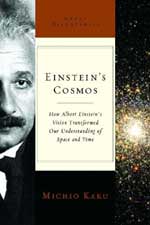
Perhaps surprisingly Einstein had a less than spectacular youth. He appeared to be more interested in reading books than developing social skills. He also had his own value system that gave greater weight to substance than imagery. From this he completed his undergraduate work with no money, no support for further education and few friends to start him on a career. Luckily one of them did find him a posting as a government patent officer. As he excelled at analyzing propositions, the work suited him. Of greater benefit was the opportunity he had to freely think about many of the questions that had been perplexing him since his early years. Through discussions with new colleagues and fortuitous circumstances in one year, 1905, he wrote his theories on special relativity, the interchangeability of matter and energy and the quantization of light. With these Einstein finally received support from the scientific community together with a doctorate and a teaching position at a university.
In as much as these theories were ground breaking postulations of their time, Einstein didn’t rest on his laurels. Much of his preceding work had been on the contemplation of light and the electromagnetic effect. Einstein’s conjectures about light were for the most part based in the nether regions of space where there was no effect from gravity. His general theory on relativity brought gravity into perspective by describing it as the bending of space and time. As Einstein was now a full member of the scientific community he instantly got support and tribulations from his colleagues. Though this was and still is the accepted method for evaluating new theories it seemed quite vicious and even somewhat personal. Nevertheless his theory prevailed with much support from a field he was not particularly good at, mathematics. In reviewing Einstein’s work mathematicians corroborated his theories and perhaps more importantly expanded them to encompass other known yet unexplained phenomena.
It was at about this time that Einstein’s fame blossomed. He went on world tours, was greeted by royalty and had the adulation usually reserved for film stars. He even saw his face depicted in stained glass at a church to which he mused, “a jew as a protestant saint?”. Aside from these existential considerations, Einstein was facing more suitable cosmological challenges. For example, if gravity is an attractive force shouldn’t the universe be contracting, eventually leading to a singularity? Einstein with the scientific community tackled this and others. Schwarzschild’s solution to Einstein’s equations led to event horizons and black holes. Mandl brought forward the idea of testing gravity by looking for the lensing of light caused by the mass of stars. These and others put Einstein’s theories to the test and continually they were found up to the task. He was due his fame.
Still Einstein continued. The jewel in the crown so to speak was the unifying theory. That is, a field theory that unified his theory of gravity with Maxwell’s theory of electromagnetism. Unity would bring together the farthest reaches of the cosmos with the smallest concepts of particles in a sensible temporal frame. Much of the last thirty years of Einstein’s life was spent looking for this theory. Mathematics shone as the tool of choice as only it could successfully represent the relations of objects too small and obscure or too large and too powerful. Yet even with this Einstein met his match. As Kaku put it, Einstein was about 50 years ahead of the necessary technology and mathematics to continue making progress.
This book by Kaku is a clean concise summary of Einstein’s activities portrayed against the technical and political challenges of the day. Kaku also discusses recent experiments that have or will provide more proof or insight. The progression from Newtonian thinking of space and time to relativistic thinking admirably describes scientific progress and the rigour to which theories are subject.
In some ways though this book may make you feel like a child in a candy store. There are many referrals to experiments and mathematical properties but no substantiation. If you know the material, the reading is easy, if you don’t you need faith or must investigate elsewhere. Also, the portrayal of Einstein is one sided in that only his positive attributes seem to be mentioned. Everyone has their off days and in adding some of Einstein’s, the portrayal would have been more balanced.
All in all, Einstein’s Cosmos aptly describes Einstein as the amazing person he was who readily deserves the praise of being one of the most influential people of the millennium. As we each age and travel with our planet through space we should take some of the precious time we are granted on Earth to read books like this and perhaps realize a clearer view of where we stand and what we can accomplish.
Buy this book and others from Amazon.com
Review by Mark Mortimer
